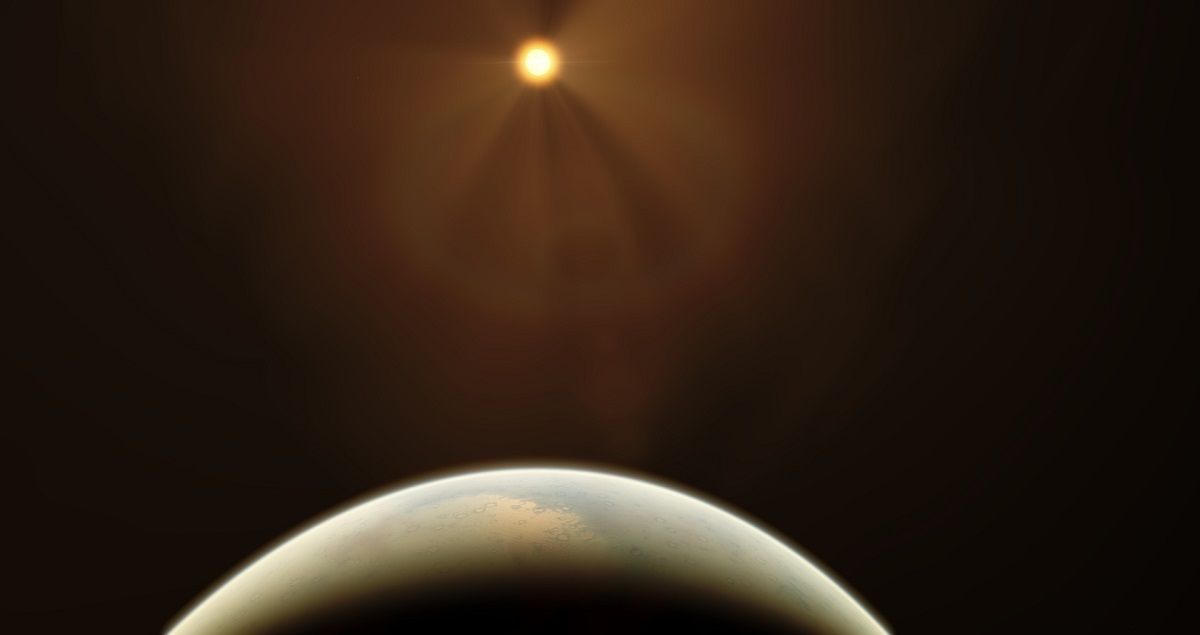Earth-like. A term used far too frequently in news headlines every time astronomers confirm the discovery of another exoplanet that's anywhere near the size of Earth. But more than a few of these proposed Earth-like worlds are more likely to be barren wastelands (ie. Mars) that don't resemble Earth very much at all. But I suppose this is just a matter of perspective.
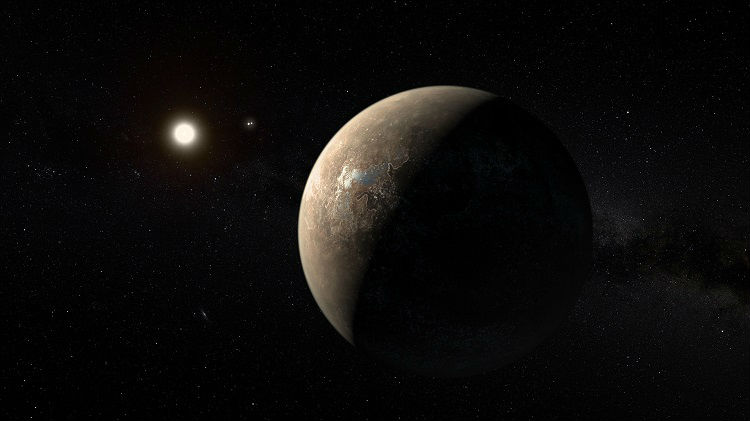 Artist's rendering of Proxima b, the closest exoplanet to Earth. Image: ESO.
Artist's rendering of Proxima b, the closest exoplanet to Earth. Image: ESO.
Earth-like planet found around nearby star. Now that's really pushing it, but I suppose it also depends on your definition of 'nearby'.
Is Mars nearby? It takes 9 months to send a probe there with our current propulsion technology. Or how about Pluto? It took ten years to send New Horizons there, and it was the fastest probe ever launched from Earth. I definitely wouldn't say Pluto is nearby, but compared to every exoplanet, it's right next door. Perspective matters.
At New Horizons' velocity, it would still take tens of thousands of years to reach the nearest possible Earth-like exoplanet, Proxima b. That's not a road trip for the faint of heart. Nearby suggests something convenient or easily accessible. So, not Proxima b at all. Nearby if your name is Kirk and you're the captain of the U.S.S. Enterprise, maybe. But this is the 21st Century, not the 23rd, and dilithium crystals don't yet exist.
There's some psychology involved in the wordplay here. The term Earth-like automatically suggests inhabited—the possibility of having found a life-bearing world, perhaps even a planet on which an alien civilization currently resides—after all, Earth is the very model of Earth-like and it's inhabited by us humans.
And nearby suggests that these inhabited worlds are places we could visit, send interstellar envoys to, or at the very least communicate with across interstellar distances. After all, it's really lonely being so isolated out here in this vast cosmos.
We're desperate to find neighbors—friends with whom we may be able to converse—and we're hopeful that there must be some such Earth-like, inhabited planet nearby. Perhaps populated by some smart Vulcan-like beings that possess the much-needed solutions to a few of our most pressing problems—like climate change, killer asteroids, and the Donald Trump. I shutter at the idea of a President Trump negotiating 'trade deals' with nearby aliens. More likely to start an interstellar Cold War, I would think.
SOME STUFF ABOUT EXOPLANETS
It's certainly a problematic term, that Earth-like. The most Earth-like exoplanet discovered so far is Kepler-43b, a slightly larger and more massive planet than Earth and which has a comparable average temperature. It orbits within its host star's habitable zone, so it could potentially support liquid water on its surface, which is (by our standards) a key ingredient needed for life (as we presently know it) to exist.
 Artist's rendering of what Kepler-43b might look like. Image: Wikimedia Commons.
Artist's rendering of what Kepler-43b might look like. Image: Wikimedia Commons.
Now for the bad news. Kepler-43b orbits its star once every 35 days (that's ten times quicker than Earth); it's also only about 25 million kilometers from its host star, which is really, really close (Earth is 150 million kilometers from the Sun).
Despite this proximity, it's possible for liquid water to exist there because the star it orbits is a red dwarf about half the size of our Sun, and it releases far less solar energy—except for when it doesn't. This particular red dwarf often has violent outbursts of solar activity powerful enough to completely sterilize the surface of Kepler-43b, killing any life forms that could potentially exist there. Water? check. Habitability? not so much.
Then there are the things we don't know about Kepler-43b: a) its chemical composition, b) whether or not it has an atmosphere, c) an accurate measurement of its mass (it could actually be anywhere from 50% to 400% Earth's mass), the list goes on.
Here's the paradox: Kepler-43b is the most Earth-like exoplanet that we're presently aware of, but it sure doesn't sound very Earth-like at all. From here, other exoplanets, even those referred to as Earth-like, get even more exotic and alien-sounding. For example, the infamous, 'Earth-like', nearby Proxima b.
In fact, Proxima b is relatively nearby (4.2 light years) compared to most exoplanets, but its other characteristics are either completely unknown or not Earth-like at all. We know that it's anywhere from 130% to 400% the mass of Earth and that it orbits its star once every elevendays (33 times quicker than Earth), but we don't know a) its radius, b) its chemical composition, c) its surface temperature, or d) if it has any sort of atmosphere; we also suspect that it's e) tidally locked, and f) could be subject to large doses of radiation, just like Kepler-43b.
So, in Proxima b, we probably have a (relatively) nearby, not at all Earth-like exoplanet on our hands. But how do we even figure all of this stuff out, and how do we know when to call an exoplanet Earth-like or not? Well, there are three primary methods used to discover and study exoplanets, each with their own pros and cons. Here's the breakdown:
1. THE DOPPLER METHOD
Gravity doesn't work in only one direction. Every object has some sort of gravitational effect on every other object in its proximity, and these effects, if large enough, can be measured.
As the Moon orbits Earth, it also tugs on the Earth, and we can see this effect directly in ocean tides. On a much larger scale, the Moon's gravity as it orbits Earth causes Earth to 'wobble' a tiny bit as it orbits the Sun, and this wobble can be measured from a distance as a slight shift in relative radial velocity.
Pluto is an extreme example of a big wobble:
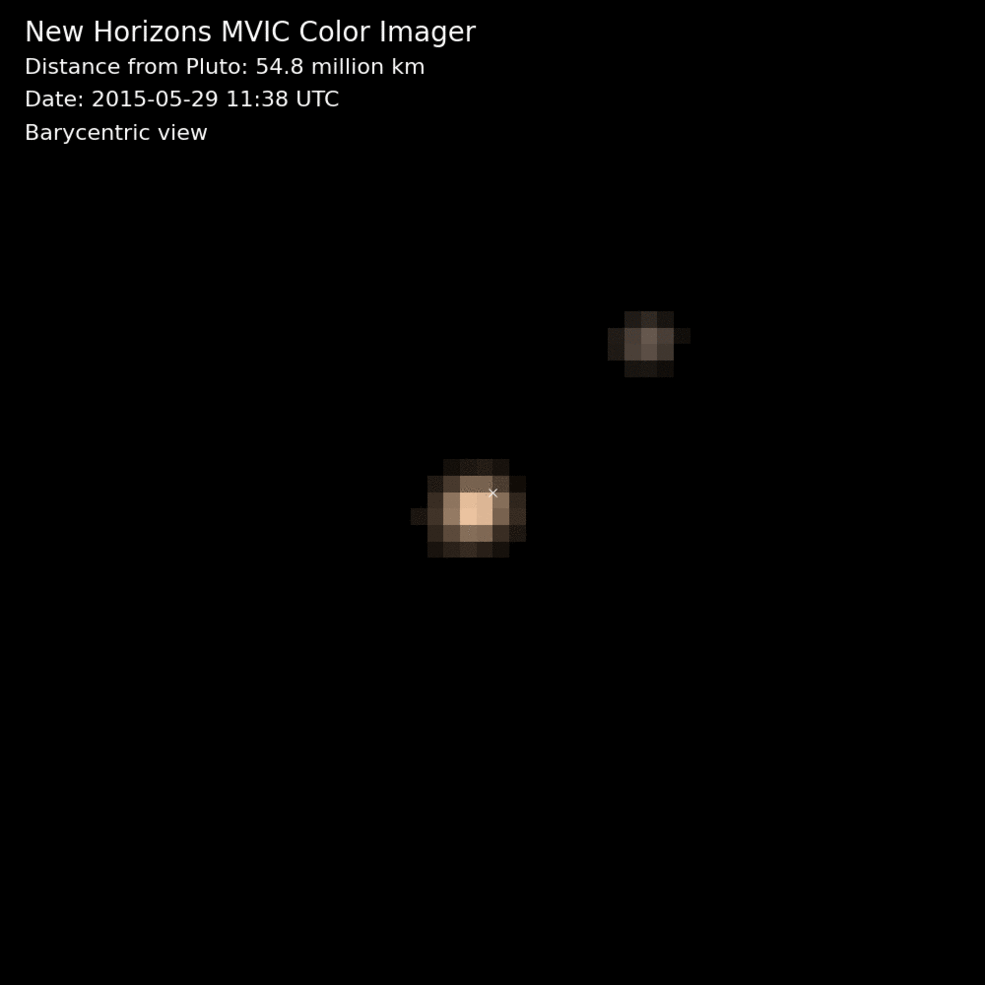 Pluto and Charon dancing around their central barycenter. Image: NASA.
Pluto and Charon dancing around their central barycenter. Image: NASA.
Pluto's moon Charon is massive enough and close enough that, as it orbits, Pluto gets yanked off of its gravitational center. This means that both Pluto and Charon are both orbiting a point in space between them both—and this central point is what orbits the Sun.
This is essentially the same method with which astronomers detected Proxima b, but seen from a different angle. As the planet goes around its host star Proxima Centauri, it slightly tugs on the star, and causes it to wobble back and forth.
As Proxima Centauri moves away from us, its light gets red-shifted (lower wavelength). As it moves towards us, its light gets blue-shifted (higher wavelength). By measuring the difference in these wavelengths, we can calculate how much the star is wobbling, and the magnitude of the wobble tells us how massive the orbiting planet must be.
The length of the wobble tells us how far away a planet is from its star (Proxima b is only 7 million kilometers from its host star and takes just 11 days to complete an orbit), and the size of the wobble tells us the planet's mass (in this case a 90% probability that Proxima b is less than three times as massive as Earth).
Earth, for example, would only alter the relative velocity of our Sun by plus or minus a fraction of a kilometer per hour over the course of 365 days—far too small of an effect to measure using present-day technology.
By comparison, Proxima b alters the velocity of its star by plus or minus dozens of kilometers per hour over the course of just 11 days—a variance large enough that it eliminates the possibility of statistical or instrumentation errors, but not quite enough to narrow down a precise mass for Proxima b, only an estimate.
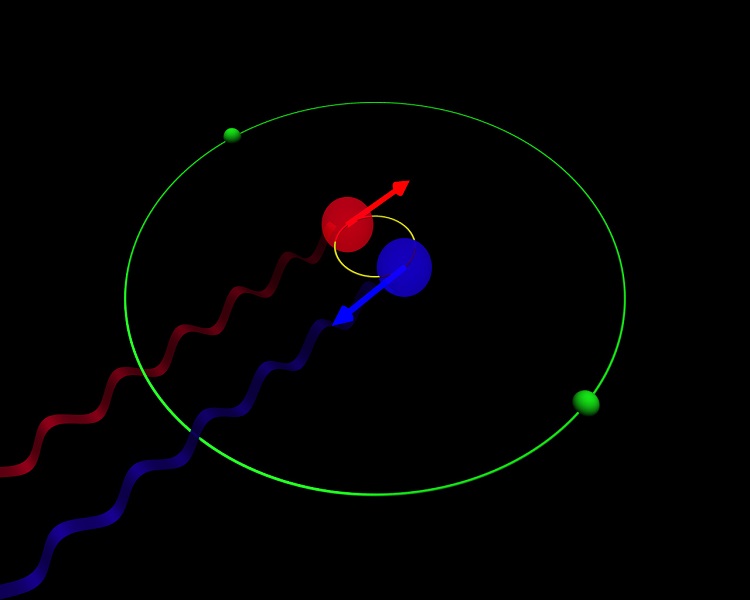 As a planet orbits around its star, the star wobbles and its light is either red-shifted (when moving away from us) or blue-shifted (when moving nearer to us). Image: Thomas Udem.
As a planet orbits around its star, the star wobbles and its light is either red-shifted (when moving away from us) or blue-shifted (when moving nearer to us). Image: Thomas Udem.
Early results using this method were good at finding really massive planets (many times the size of Jupiter) orbiting extremely close to their stars, because this produced the largest possible change in radial velocity (and subsequently the most noticeable red-shift/blue-shift).
Today, astronomers are able to detect either large planets orbiting at moderate distances from their host star or smaller planets (Earth-size) orbiting very close to their host star. An Earth-size planet orbiting at an Earth-like distance from its star would produce an almost immeasurable effect on its star's radial velocity (using current technology), and we still have a long way to go before our instruments are accurate enough to start finding actual Earth-like worlds.
With improved technology, we'll eventually be able to determine the size and number of orbiting planets with far greater accuracy and higher frequency. This will at least give us the ability to discover most of the exoplanets in our galaxy given enough time, though this method is limited to only being able to determine a planet's orbital period and mass. In order to determine other (more Earth-like) properties, we'll need to employ other methods.
2. THE TRANSIT METHOD
When a planet passes between us and its host star, it dims a very small percentage of the star's light (unless it's the curious case of Tabby's Star, in which case it's a LOT of light)—sort of like watching a mini-eclipse, but viewed from dozens, or hundreds, or even thousands of light years away.
This is how the vast majority of exoplanets have been discovered, thanks in large part to NASA's uber-successful Kepler Space Observatory. By measuring the dip in starlight caused by a transiting planet, astronomers are able to determine a few of the planet's characteristics. These include a) orbital period (determined by length of the dip), b) planet radius (determined by size of dip), c) presence of an atmosphere, d) some idea about surface temperature, and e) an indirect measurement of its chemical composition.
By far the biggest advantage of the Transit Method is the ability to detect the chemical composition of an exoplanet as it transits its host star. By analyzing at the difference between transit and non-transit light spectra, astronomers can determine the chemical composition of the transiting planet (because we know that the presence of certain elements blocks specific wavelengths of light from reaching our telescopes).
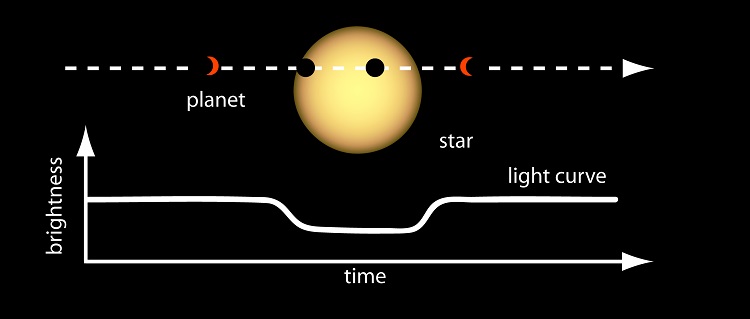 This is what happens when a planet walks in front of its star. Image: NASA Ames.
This is what happens when a planet walks in front of its star. Image: NASA Ames.
As far as discovering potentially Earth-like planets goes, transit photometry far outperforms the Doppler method by providing us with a lot more data. Studying the chemical composition of a planet as it passes in front of its star may even allow us to one day detect bio-signatures—such as oxygen molecules—in the atmospheres of alien worlds. That would certainly be something to get all Earth-like about.
Unfortunately, transit photometry only works on a small percentage of stars—namely those that we're able to look at edge-on. If a star system isn't perfectly aligned with our angle of perspective here on Earth, then we'll never even see an exoplanet make a transit of its star. And this seems to be the case with Proxima b: we were able to detect the planet using the Doppler method, but the system just isn't angled correctly for us to catch a transit event from Earth. In astronomy, perspective matters.
While the Transit Method allows us to take large surveys of the galaxy and make extrapolations based on the small percentage of transits we're able to actually see, it has very limited applications for looking closely at specific star systems, like Proxima Centauri. Fortunately, there's an even better method of detecting these non-transiting planets, and all it requires is a really, really big telescope.
3. EMERGING TECHNOLOGY: DIRECT IMAGING
Current generation telescopes aren't quite powerful enough to capture direct images of most exoplanets, unless those planets are really far away from their host stars (so that starlight doesn't block light from the planet). Like this one:
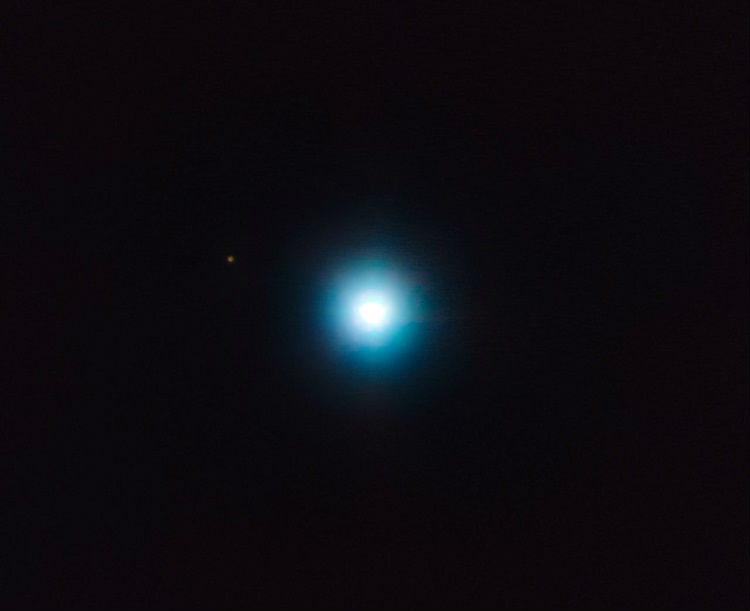 Here's an image of an exoplanet, CVSO 30c, orbiting almost 100 billion kilometers away from its host star. At that distance, it would take 27,000 years to complete a full orbit (similar to our fabled Planet 9). Image: ESO/Schmidt et al.
Here's an image of an exoplanet, CVSO 30c, orbiting almost 100 billion kilometers away from its host star. At that distance, it would take 27,000 years to complete a full orbit (similar to our fabled Planet 9). Image: ESO/Schmidt et al.
Yes, that tiny little yellowish-brown speck is an exoplanet 1,200 light years away, known as CVSO 30c, orbiting really far away from its host star (about 650 times further out than Earth's orbit around our Sun). Yes, this is a real-life image of an alien planet around a distant star. Here's a zoom-in:
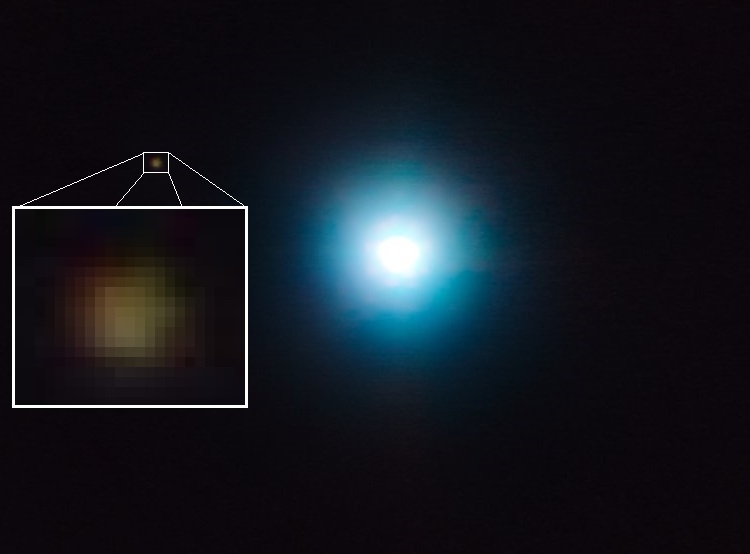 Here's your close-up, exoplanet. Image: ESO/Schmidt et al.
Here's your close-up, exoplanet. Image: ESO/Schmidt et al.
One day, we'll be able to capture an image like this for Proxima b. But It'll require bigger and better telescopes, and the ability to block out starlight in order to resolve the actual planet. The only reason astronomers were able to capture light from CVSO 30c is because it orbits so incredibly far away from its host star. Proxima b is just too close to its host star to be seen, blocked by the brightness of Proxima Centauri.
Direct imaging allows for a far more intensive study than either the Doppler or Transit methods, enabling astronomers to more accurately determine chemical compositions and make direct measurements of a planet's atmosphere (as opposed to the indirect methods of transit photometry).
Using the next-generation of massive telescopes that'll be coming online within the next few decades, we'll eventually be able to find evidence of life, or at least of potentially life-supporting worlds, in the cosmos. Perhaps this method will even allow us to find evidence of technological civilizations similar to our own—worlds that really are Earth-like.
A BRIGHT FUTURE FOR EXOPLANETOLOGY
Based on extrapolations from Kepler data, it's estimated that our galaxy could contain as many as 40 billion Earth-sized exoplanets orbiting inside the habitable zones of their host stars. But does that mean that they're actually Earth-like, or even habitable? Not by a long shot.
Of these 40 billion Earth-sized worlds, we've only actually discovered a few dozen that appear to reside in habitable zones. This means that there's more than a billion times more potentially Earth-like worlds out there than we currently know about. While the first few dozen haven't been the most promising candidates for habitability, if we keep going, we're eventually going to find one that's a lot like Earth in nearly every conceivable way.
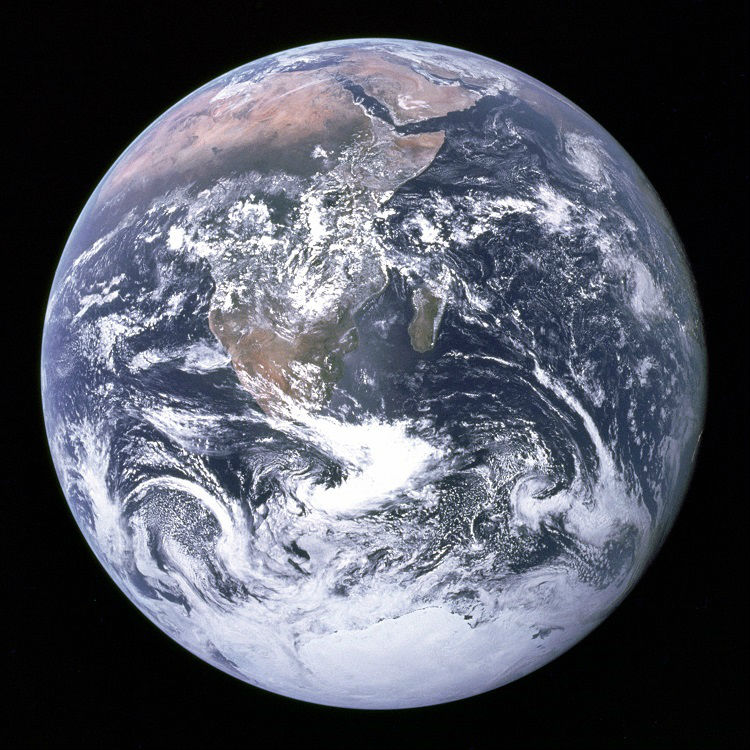 Exoplanet images as detailed as this are a really long way off. Image: NASA/Apollo 17 crew.
Exoplanet images as detailed as this are a really long way off. Image: NASA/Apollo 17 crew.
One day, we will find evidence of life in the cosmos, whether it be from detecting molecular Oxygen, Carbon Dioxide, or Methane in a planet's atmosphere, or even from capturing the 'greenness' of a planet's surface vegetation. It's scientifically possible, but we don't have the technological ability to do so quite yet.
It's going to take some really, really big telescopes—and lots of them—in order to confirm the first real Earth-like exoplanets. A few of these next-generation telescopes will come online in the 2020's, so we have a lot to look forward to. But for now, the only Earth-like planet we know about is the one we're presently living on.

